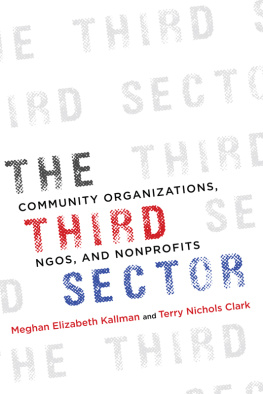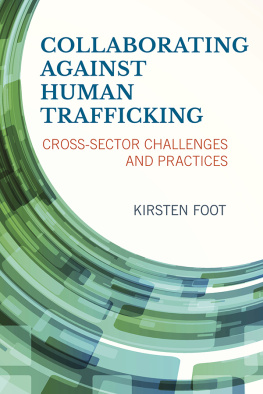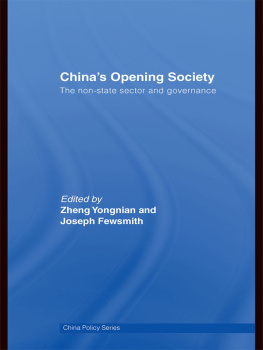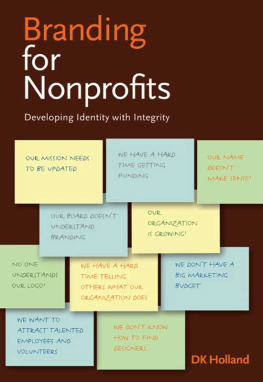Introduction
Democratic Governance and Institutional Logics within the Third Sector (or, How Habermas Discovered the Coffee House)
It would be well to infuse political life into each portion of the territory, in order to multiply to an infinite extent opportunities of acting in concert for all the members of the community, and to make them constantly feel their mutual dependence on each other if the object be to have the local affairs of a district conducted by the men who reside there, the same persons are always in contact, and they are, in a manner, forced to be acquainted, and to adapt themselves to one another.
Alexis de Tocqueville
CSOs (civil society organizations), NPOs (nonprofit organizations), NGOs (nongovernmental organizations), INGOS (international nongovernmental organizations), and formal and informal associations are part of an important, relatively new sector that is now a world political force. Though the components of this third sector vary by country, their net effect is increasingly important across the globe. This third sector plays a critical role in creating values worldwide, through its work in service delivery, advocacy, cultural programs, and social movements. The third sector includes different types of relief and welfare organizations, innovation organizations, public service organizations, economic development organizations, grassroots mobilization groups, advocacy groups, and social networks (J. Clark 1991:4041).
This book is an international comparison of third sectors. It builds on recent work on the origins, dynamics, and effects of civil society in different parts of the world; we include the political-historical background and third sector interactions with state institutions, as well as analysis of how those dynamics vary by region. We then examine functions, impacts, and composition of the nonprofit sector for six key countries.
Foundational differences in religious and political tradition across these different countries create different types of meanings for third sector organizations. Contexts shift drastically, internationally and over time. A childrens art group, for example, means something very different in a wealthy Los Angeles suburb than in a poor Lima neighborhood. Chinese civic organizations, for example, follow the predominantly Asian model of being funded largely by government and are linked to goals of national politics. This contrasts with Western experience of the third sector, which has often explicitly challenged government objectives. Most existing studies are of one or a few countries; moving to a global perspective adds considerable insights in highlighting variations and offers policy options of borrowing across national systems. We hope in this book to encourage others to look more sensitively at different national systems.
This study began at an invitation from the Chinese government in 2009 and was published in Mandarin in 2011. This English version incorporates new material for a more global audience, emphasizing the presence of different institutional logics born of different cultural traditions and historical trajectories. The books history thus led to a national policy-oriented perspective informing the broader theoretical observations below. As such, it is our hope that it constitutes a useful guide for a wide variety of audiences, ranging from policymakers who may find it useful to locate their work within a broader context, to academics looking for a comparative frame to situate their own scholarship, to third sector practitioners, who may find reflections and insights germane to their careers.
We begin with questions of legitimacy and trust that have affected leadership in recent decades. As the conflicting and conflating forces of neoliberalism, egalitarianism, and globalization have interacted uneasily with traditional models of leadership and citizen participation, leaders around the world have sought to counter negative impacts of such unsettled culture through projects of participation, decentralization, and associationalism. Where and why do these work or fail? There is much to learn by reviewing successes and failures globally.
Our introduction offers new theoretical perspectives on how different types of participation can increase generalized trust and state legitimacy, and more importantly, how the different institutional logics within the third sector articulate globally. We progress through cross-national comparisons to specific elements of these different third sectors. examine the development and infrastructure of the nonprofit sectors in the United States, France, Japan, Korea, Taiwan, and China, respectively.
. The conclusion analyzes some of the regional and national differences between third sectors, discussing how the different dynamics of third sectors may lead to different political outcomes more broadly.
Generally speaking, the countries examined fall into one of two categories: those with a strong central state andwe argue, consequentlya weaker involvement of third sector organizations in some regards, and those comparatively weak national governments with historically strong third sector organizations. These differences have important implications for current policy debate and changes of the third sector in each country. Countries with historically weak state involvement (like the United States) often have a third sector that began as an independent sector and more recently has moved closer to government. Countries with strong state traditions (like China and Japan) generally have had a government-linked third sector and more recently diversified to include more advocacy-oriented activities. As these two categories move toward one another, participants can learn from one another, if one recognizes these broad policy shifts and looks for cross-national lessons.
Often referred to as the nonprofit sector, the third sector is ironically characterized by a relative failure to settle on a common definition of what, precisely, it is, and where its boundaries lie. Technically and philosophically, the third sector itself has undergone variations in nomenclature worldwide. Five crucial features of third sector organizations have been widely identified in the literature (see Salamon, Hems, and Chinnock 2000:8). Fundamentally, the third sector can be conceptualized as a set of entities that is composed of organizations that are self-governing, do not distribute profit, are primarily private and nongovernmental in basic structure, and are meaningfully voluntary , thus likely to engage constituents on the basis of shared interest. This definition we follow throughout the book.
 This book is printed on acid-free paper.
This book is printed on acid-free paper.








